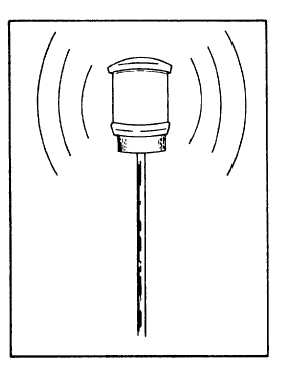| |
made immediately after the signal made by the towing
vessel.
When a pushing vessel and a vessel being pushed
ahead are rigidly connected in a composite unit, they
will be regarded as a power-driven vessel and give the
signals prescribed earlier for a power-driven vessel
making way through the water or a vessel underway but
stopped and making no way through the water.
A vessel at anchor must, at intervals of not more than
1 minute, ring the bell rapidly for about 5 seconds. In a
vessel of 100 meters or more in length, the bell must be
sounded in the forepart of the vessel; and immediately
after the ringing of the bell, the gong must be sounded
rapidly for about 5 seconds in the afterpart of the vessel.
A vessel at anchor may, in addition, sound three blasts
in succession; namely, one short, one prolonged, and
one short blast to give warning of its position and of the
possibility of collision to an approaching vessel.
In addition to giving the bell signal and, if required,
the gong signal prescribed above, a vessel aground must
give three separate and distinct strokes on the bell
immediately before and after the rapid ringing of the
bell. A vessel aground may, in addition, sound an
appropriate whistle signal.
A vessel of less than 12 meters in length is not
obliged to give the above-mentioned signals but, if it
does not, the vessel will make some other efficient sound
signal at intervals of not more than 2 minutes.
NOTE
The following paragraph from the
International Rules is not included in the Inland
Rules:
“Any light to attract the attention of another
vessel will be such that it cannot be mistaken
for any aid to navigation. For that reason, the
use of high-intensity intermittent or revolving
lights, such as strobe lights, must be avoided”.
There is no basis in the Rules of the Road for the
popular notion that the national ensign hoisted upside
down is a recognized signal of distress. No man-of-war
would ever subject the colors to this indignity. But if you
should see a private craft with the ensign hoisted upside
down, it is probably in distress. See figure 5-17 for
distress signals under the International and Inland Rules.
The signals in figure 5-17 may be used or exhibited
either together or separately, to indicate distress and
need of assistance.
NOTE
There is no provision in the International
Rules for the distress signal shown in figure
5-18.
A pilot vessel, when engaged on pilotage duty, may,
in addition to the signals prescribed for a power-driven
vessel underway making way through the water;
underway but stopped and not making way through the
water; or at anchor; sound an identity signal consisting
of four short blasts.
DISTRESS SIGNALS
The International and Inland Rules on signals to
attract attention are almost identical. They are as
follows:
If necessary to attract the attention of
another vessel, any vessel may make light or
sound signals that cannot be mistaken for any
signal authorized elsewhere in these rules, or
may direct the beam of its searchlight in the
direction of the danger in such a way as not to
embarrass any vessel.
Figure 5-18.–A high-intensity white light flashing at regular
intervals from 50 to 70 times per minute.
5-25
|

